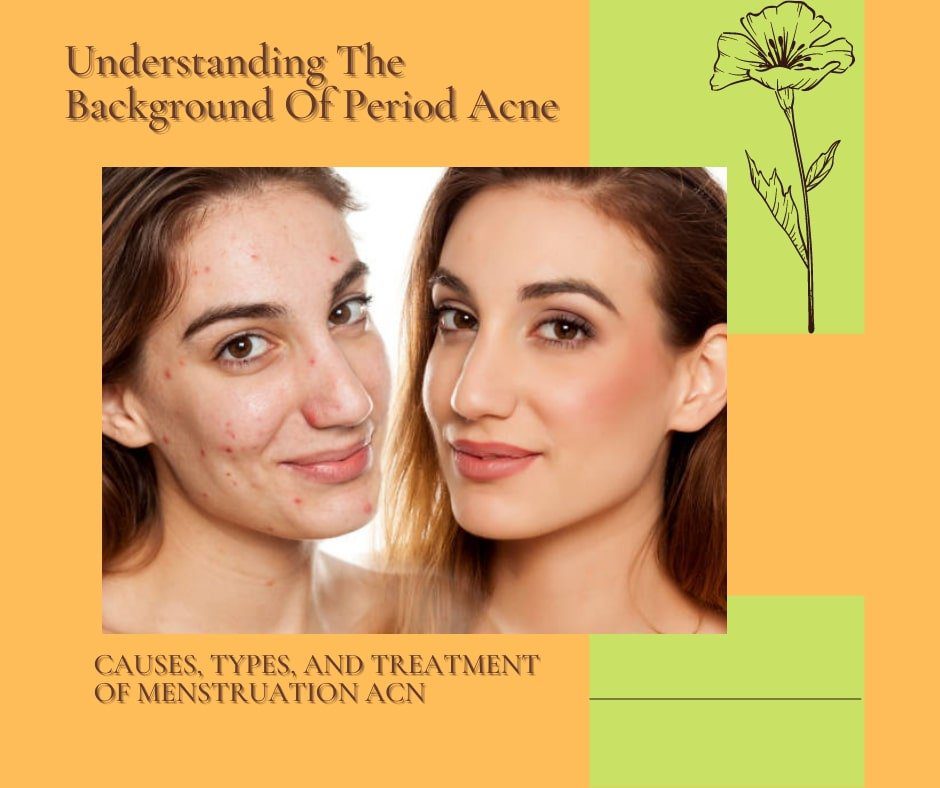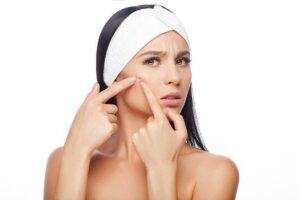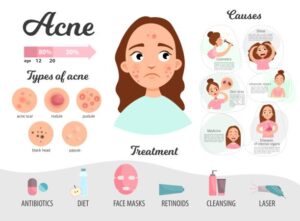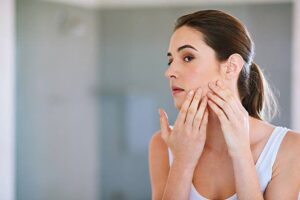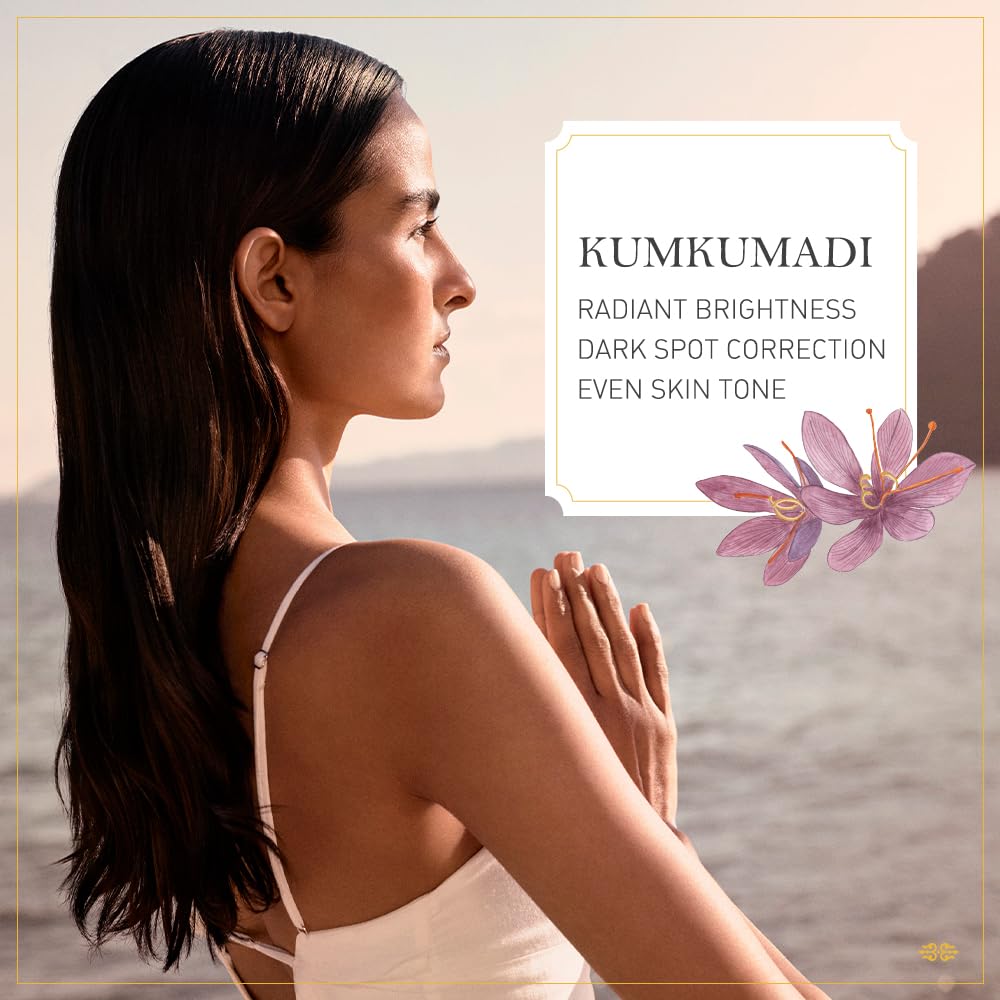Acne is a skin disorder brought on by an excess of sebum (oil) in the pores. Acne can appear anywhere on your body, including your face, back, neck, shoulders, and chest. Acne can appear on any part of your body, including your back and thighs. Acne thoughts cause excessive oil production.
Most women’s periods, or menstruation, are the only time of the month when they get acne. This is also the only period of the month when women are at a greater risk of having a full-blown case of acne, or acne as we know it.
While there are a variety of different causes of acne, which we must go over in further depth later, one of the most common is The presence of hormones in the female body, estrogen, which is one of the most usually mentioned explanations.
The amount of estrogen in a woman’s body fluctuates throughout the month, following a pattern that links to her menstrual cycle.
Have you ever noticed how your skin gets red and irritated right before your period? Period acne is most likely your body’s way of prepping for acne.
Period acne, unlike the acne we associate with adolescence, can affect women of any age. In fact, it is believed that up to 40% of women may suffer from period acne at some point during their lives.
Acne is the bane of a lot of people’s lives. It appears to attack without notice, and it has the ability to completely destroy everything in its path. sabotage our self-esteem and ruin our day But did you know there’s another sort of acne that manifests itself in a similar fashion, appearing at random?
Period acne, often known as “menstruation acne,” is a type of acne that occurs during a woman’s monthly cycle.
Period acne is a word used to describe acne that appears during a woman’s menstrual period. Hormone swings in the body generate clogged pores, trapping oil and bacteria inside.
Women in their teens and twenties are the most likely to affect but it can afflict women of any age. It’s a complicated issue that often takes a lot of cosmetic aid to get rid of.
1. The definition of menstrual acne
Acne is a skin condition that can affect any part of the body, including the face, chest, back, and shoulders. But, face acne is the most frequent type of acne. Although the exact causes of acne are unknown, your diet, hormones, and the types of bacteria on your skin may all play a part. Acne that arises during your menstrual cycle is one of the most prevalent types of acne.
Adults, particularly those in their teenage years, are susceptible to acne. Acne can strike individuals in their twenties, thirties, forties, and fifties. “Period acne” or “menstrual acne” are terms used to describe acne in these older age ranges. We’ll talk about it in this article.
We’ll talk about the reasons and types of menstrual acne, as well as the many sorts of acne treatments that are available.
Acne is very frequent in adults. Acne vulgaris, often known as acne vulgaris, is a type of acne that can appear in a variety of ways. Period acne, known as menstrual acne, is the most frequent type of acne in adults. Acne vulgaris is a chronic skin ailment that can affect the face, back, chest, and other body parts.
Acne that arises during menstruation is referred to as “period acne.” Open comedones, closed comedones, papules, and pustules are the three basic forms of acne. Many females’ skin grows greasy during adolescence.
and prone to acne Because the hormones generated by the skin’s glands boost oil production and make the pores more active, this happens.
2. What is the cause of menstrual acne?
Hormones are to blame for menstruation acne. A sudden spike in androgen (a kind of hormone) levels in the body, in particular. The ovaries of a female create an egg as a result of this. Ovulation raises androgen levels, which causes the ovary’s skin cells to produce more oil than usual.
Acne is a skin disorder that results in tiny patches and blackheads on the face. Teenagers are the most affected, but, adults can also affect. The source of most acne is unclear, but in cases with severe acne, doctors can determine the cause. Menstrual acne, for example, causes an imbalance of female sex hormones known as androgen excess.
The emergence of period acne is referred to as “period acne.”
During a woman’s monthly cycle, she gets acne on her face and body. It’s caused by an increase in hormones, which activate the skin’s oil glands, causing an increase in sebum production. The skin becomes clogged with dead skin cells, resulting in blocked and inflamed pores. Excess sebum, dead skin cells, and bacteria are the causes of acne.
Period acne is a form of acne that occurs in the days leading before a woman’s period. It can create pimples on the face, neck, chest, and back that are red, inflamed, and painful. It’s caused by hormones and sometimes works in tandem with existing acne, making it harder to clear up. But, often, there are underlying factors.
Diet, stress, lifestyle, and heredity are all factors. Acne is a skin disorder characterized by tiny patches and blackheads. Acne develops when small glands beneath the skin become clogged, causing oil to build up. Acne affects people of all ages, but it is most associated with adolescence. Acne develops when small glands in the skin become clogged, causing oil to accumulate.
3. What are the causes, types, and treatments of menstrual acne?
One of the most common skin disorders is acne, which characterizes tiny, red pimples on the skin. It can affect people of many ages and backgrounds, producing severe mental and physical anguish in certain cases. Acne isn’t a cosmetic concern; it can also lead to emotional and social issues including low self-esteem and depression.
Dirt, sweat, and oil build up in the pores, causing an infection, which causes acne. Period acne, sometimes called menstrual acne or acne vulgaris, is a kind of acne that affects women and girls throughout their menstrual cycles.
Changes in hormone levels cause the endometrial (uterine lining) to shed and induce inflammation in the surrounding tissue, resulting in PMS. Acne during your period is a common occurrence.
Acne vulgaris is one of the most common types of acne, affecting millions of women around the world. Small whiteheads to big inflammatory cysts and pustules are all possible symptoms.
Period acne is a frequent ailment that affects women right before and throughout their menstrual cycle. It produces the hormone progesterone and generates little red spots on the skin, and on the chin.
The exact reasons for period acne are unknown, although they are likely to be a combination of variables, such as hormonal influences and skin sensitivity to various products. Period acne causes the skin’s sensitivity to particular substances in items like soaps and deodorants in some women.
Period acne, also known as menstrual acne, is a kind of acne that occurs throughout the menstrual cycle.
During a woman’s menstrual cycle, it occurs in her vaginal area or around her pelvic region. Changes in a woman’s hormone levels lead the glands in her skin to generate too much oil, which causes acne.
Some women receive a minor bit of acne in their genital area right before their period, while others get a full-blown acne eruption in their genital area before the start of their period. Period acne can range in severity from mild to severe, with some women having only a few whiteheads and blackheads and others having severe acne that causes scars.
Acne is one of the most common skin problems, and it affects the majority of people at some point in their lives. Acne causes deep-seated skin cells.
clogging and infecting, resulting in redness, edema, and pus Acne is found on the face and neck, but it can also be found on the back, chest, and shoulders. Acne is most associated with adolescence, but it can also afflict adults.
4. What are the symptoms of menstrual acne?
Acne is very frequent throughout puberty and adolescence. Period acne is the most prevalent type of acne that appears during a woman’s menstrual cycle. Acne causes puberty’s hormonal changes, such as increased amounts of androgens (a type of hormone) in the blood.
Other acne forms, such as post-acne scarring acne, cause puberty’s hormonal changes and do not occur during a woman’s menstrual cycle.
Acne most emerges during a woman’s menstrual cycle. Menstrual acne is another name for it. Acne may emerge at various times of the month or not at all for some people. Acne can strike at any age, while it is most frequent during puberty and adolescence.
Acne is a skin condition that affects many people. a frequent skin problem affecting teenagers and young adults. When hair follicles become clogged with oil and dead skin cells, this occurs. A pimple forms when there is an excess of oil and dead skin cells mixed with the hair follicle’s natural inclination to enlarge.
Acne is more common in the T-zone and face, where the skin is more prone to oil and dead skin cell buildup. Menstrual acne, known as period acne, is acne that develops during menstruation. It’s a sort of acne that only appears during a woman’s period.
Acne becomes worse and more difficult to treat as a result of hormonal changes that occur during menstruation. But, there are several exceptions.
There are still a lot of misconceptions and myths about menstruation acne. Acne is a common skin ailment that affects the face and neck’s pores and glands. Acne can affect anyone, although it is more frequent in teenagers and young adults.
Acne’s causes are misunderstood, and some people try to avoid getting their period because of the acne that occurs. Acne sufferers have a variety of treatment options, including prescription and natural remedies.
5. How the menstrual cycle influences acne?
Acne occurs when your skin’s pores become blocked with dead cells and oil, causing spots to appear. It’s a common skin condition that affects people of all ages and backgrounds, but it’s usually a minor issue that can treat.
Acne can sometimes develop into a long-term condition, with patches reappearing even when you don’t have a spot or a pimple. This is referred to as “period acne,” and it occurs a week or so before your period, or before it starts.
Acne is a prevalent skin problem that affects millions of people throughout the world. But, the problem isn’t confined to teenagers. Acne flare-ups are common among women while they’re pregnant.
“Period acne” is the term for when a woman is menstruating. Period acne, like other types of acne, causes hormones and bacteria that activate the menstrual cycle.
The menstrual cycle has a significant impact on our skin, not in terms of generating acne, but also on how our skin acts throughout menstruation. Our skin can react in surprising ways due to hormonal imbalances that occur during our menstrual cycle.
Acne flares up for some women during their periods. Others report that their acne is improving.
Acne affects every woman at some point in their life. Some ladies have a pimple now and then, while others suffer from serious breakouts on a daily basis.
The menstrual cycle is a cycle that occurs every month. For many women, has a large impact on acne. Acne flares up for some women immediately before their period.
On the first day of their period, some women get breakouts, a distressing condition that is generally blamed on hormones. The cycle, but, has a significant impact on the skin, with acne growing more severe at certain periods of the month.
Hormones can create a shift in the skin’s microbiome, or the population of microorganisms that dwell on the surface of the skin, which can have a major impact on health. The items we use can also induce breakouts, especially if they contain substances that create inflammation.
6. Treatment of menstrual acne
Acne is a skin problem that affects people of all ages. Acne is most linked with acne lesions or pimples, but it can also affect parts of the body not associated with acne. Acne lesions are oil-filled nodules on the skin that contain dead skin cells. The bacteria that causes acne thrive on the oil in the lesion.
When a woman is on her period, the severity and look of her acne outbreaks may worsen. Menstrual acne, often known as “period acne,” is acne that develops during a woman’s menstrual cycle. Although many women get acne during their menstrual cycle, those who have menstrual acne may have more severe symptoms.
acne that is more severe and widespread than acne that appears at other points during their cycle. Acne can sometimes appear at a younger age, appear to be caused by hormonal shifts, and continue for months or even years.
Acne is a common skin ailment that affects a large number of people. Acne lesions on the face, chest, back, and shoulders are all common. Acne can be so severe in some circumstances that it disfigures the skin and causes emotional suffering. If you have acne, there are many treatment options that might help you cut the severity of your condition.
Acne with menstruation is quite prevalent in women of reproductive age. While acne is a complicated skin issue, there are certain things you may do to help.
have links to acne breakouts during menstruation. The following is an outline of the causes of menstrual acne and how to cure it.
Acne is a common skin disorder characterized by tiny lumps on the skin that look like pimples. Acne is most associated with adolescence, although it can also affect adults.
Acne is almost always caused by excessive oil production on the skin. Acne can be caused by a variety of factors, including hormonal changes, infection, and the use of certain medications.
Conclusion: Menstrual acne can be treated with just a few simple steps
Acne breakouts are common during adolescence and early adulthood, and most people are familiar with them. Redness, swelling, and small pimples on the skin are characteristic symptoms of this form of acne, also known as common acne.
Many individuals are unaware, but, that acne can also be caused by other factors, such as the menstrual cycle. In fact, menstrual acne is becoming common among adolescent females, with up to 28% of acne sufferers being female.
Acne can be a problem for some women during their periods. Menstrual acne is the common name for this type of acne. The following are the two most prevalent types of menstrual acne.
Acne can strike at any age, but teenagers are the most susceptible. Acne develops when pores become clogged with oil and dead skin cells.
germs, oil, and dead skin cells Whiteheads and blackheads form on the skin when you have acne. It can also result in the formation of little, painful pimples.
Acne is most common during adolescence, and it’s generally linked to puberty hormones. But, acne can appear at any age, and not all acne is associated with puberty. Acne vulgaris, or common acne, is a kind of acne that only appears throughout puberty or adolescence. Other types of acne, such as menstrual acne, arise before, during, and/or after menstruation.
Acne is a prevalent skin disorder that affects millions of individuals worldwide. While oil production in the pores is the most prevalent cause of acne, there are situations when the cause of acne is more complicated.
complex. Menstrual acne is one of the most common causes of acne in women. Acne that develops during periods is not limited to the menstrual cycle, despite its name.

